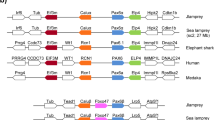Abstract
THE Pax-6 genes are important for eye development in both vertebrates and Drosophila. Mutations in the human PAX6 gene are found in patients with a variety of eye disorders, including aniridia and Peters′ anomaly1á¤-3, and mutations in the Drosophila Pax-6 homologue cause the eyeless phenotype4. In the nematode Caenorhabditis elegans vab-3 mutants display many defects in head-region development, including aberrant morphogenesis, trans-formation of hypodermal (epidermal-like) cell fates to those of posterior homologues, and abnormal specification of neurons. Here we show that vab-3 is a member of the paired-domain-containing Pax-6 gene family and is expressed in head-region cells. This C. elegans Pax-6 locus can also encode proteins lacking the paired domain5. Our results suggest that a primordial role of the Pax-6 gene family could have been to pattern part of the head region, and that Pax-6 genes subsequently evolved to be more specifically involved in eye development.
This is a preview of subscription content, access via your institution
Access options
Subscribe to this journal
Receive 51 print issues and online access
$199.00 per year
only $3.90 per issue
Buy this article
- Purchase on Springer Link
- Instant access to full article PDF
Prices may be subject to local taxes which are calculated during checkout
Similar content being viewed by others
References
Jordan, T. et al. Nature Genet. 1, 328–332 (1992).
Hanson, I. M. et al. Nature Genet. 6, 168–173 (1994).
Glaser, T. et al. Nature Genet. 7, 463–471 (1994).
Quiring, R., Walldorf, U., Kloter, U. & Gehring, W. Science 265, 785–789 (1994).
Zhang, Y. & Emmons, S. W. Nature 377, 55–59 (1995).
Lewis, J. A. & Hodgkin, J. A. J. comp. Neurol. 172, 489–510 (1977).
Sulston, J. E. & Horvitz, H. R. Devl Biol. 56, 110–156 (1977).
Chamberlin, H. M. & Sternberg, P. W. Devl Biol. 170, 679–689 (1995).
Walther, C. & Gruss, P. Development 113, 1435–1449 (1991).
Balling, R., Deutsch, U. & Gruss, P. Cell 55, 531–535 (1988).
Xu, W., Rould, M. A., Jun, S., Desplan, C. & Pabo, C. O. Cell 80, 639–650 (1995).
Hanson, I. M. et al. Hum. molec. Genet. 2, 915–920 (1993).
Püschel, A. W., Gruss, P. & Westerfield, M. Development 114, 643–651 (1992).
Li, H.-S., Yang, J.-M., Jacobson, R. D., Pasko, D. & Sundin, O. Devl Biol. 162, 181–194 (1994).
Chalfie, M., Tu, Y., Euskirchen, G., Ward, W. W. & Prasher, D. C. Science 263, 802–805 (1994).
Grindley, J., Davidson, D. R. & Hill, R. E. Development 121, 1433–1442 (1995).
Scott, M. P. Cell 79, 1121–1124 (1994).
Zuker, C. Science 265, 742–743 (1994).
Halder, G., Callaerts, P. & Gehring, W. Science 267, 1788–1792 (1995).
Burr, A. H. Photochem. Photobiol. 41, 577–582 (1985).
Mello, C. C., Kramer, J. M., Stinchcomb, D. & Ambros, V. EMBO J. 10, 3959–3970 (1991).
Barstead, R. J. & Waterston, R. H. J. biol. Chem. 264, 10177–10185 (1989).
Okkema, P. G. & Fire, A. Development 120, 2175–2186 (1994).
Glaser, T., Walton, D. S. & Maas, R. L. Nature Genet. 2, 232–238 (1992).
Czerny, T. & Busslinger, M. Molec. cell Biol. 15, 2858–2871 (1995).
Martin, P. et al. Oncogene 7, 1721–1728 (1992).
Bürglin, T. R. in Guidebook to the Homeobox Genes (ed. Duboule, D.) 25–71 (Oxford Univ. Press, 1994).
Clark, S. G., Chisholm, A. D. & Horvitz, H. R. Cell 74, 43–55 (1993).
White, J. G., Southgate, E., Thomson, J. N. & Brenner, S. Phil. Trans. R. Soc. B314, 1–340 (1986).
Seydoux, G. & Fire, A. Development 120, 2823–2834 (1994).
Clark, S. G., Lu, X. & Horvitz, H. R. Genetics 137, 987–997 (1994).
Author information
Authors and Affiliations
Rights and permissions
About this article
Cite this article
Chisholm, A., Horvitz, H. Patterning of the Caenorhabditis elegans head region by the Pax-6 family member vab-3. Nature 377, 52–55 (1995). https://doi.org/10.1038/377052a0
Received:
Accepted:
Issue Date:
DOI: https://doi.org/10.1038/377052a0
This article is cited by
-
A 4D single-cell protein atlas of transcription factors delineates spatiotemporal patterning during embryogenesis
Nature Methods (2021)
-
Pax6 in Collembola: Adaptive Evolution of Eye Regression
Scientific Reports (2016)
-
A Genetic Perspective on Eye Evolution: Gene Sharing, Convergence and Parallelism
Evolution: Education and Outreach (2008)
-
Eyes absent: A gene family found in several metazoan phyla
Mammalian Genome (1997)
-
Specification of sense-organ identity by a Caenorhabditis elegans Pax-6 homologue
Nature (1995)
Comments
By submitting a comment you agree to abide by our Terms and Community Guidelines. If you find something abusive or that does not comply with our terms or guidelines please flag it as inappropriate.



